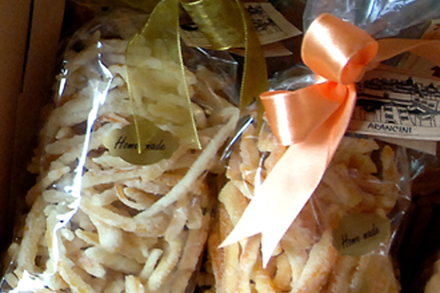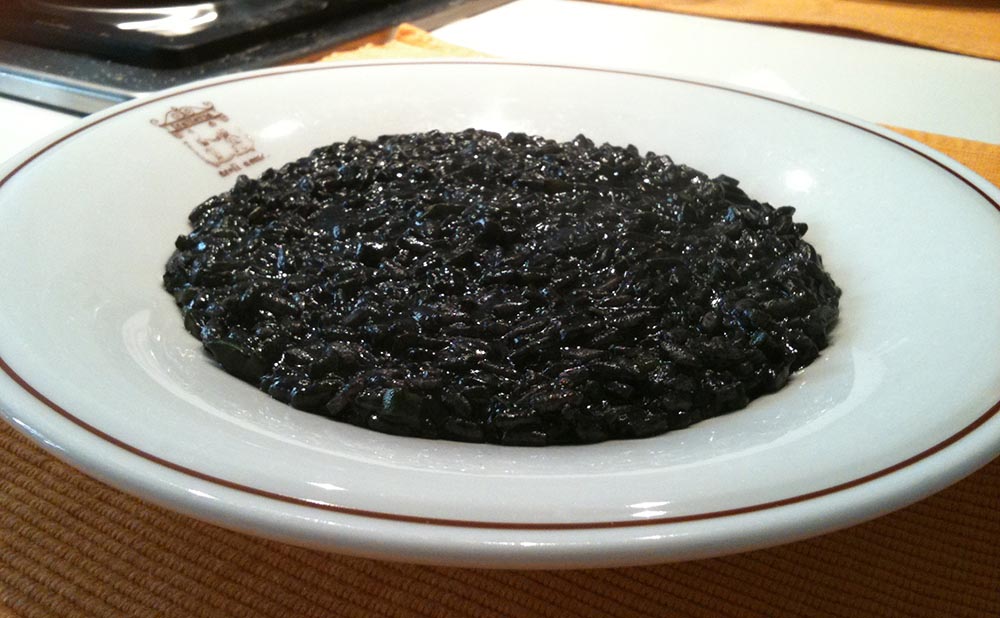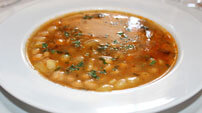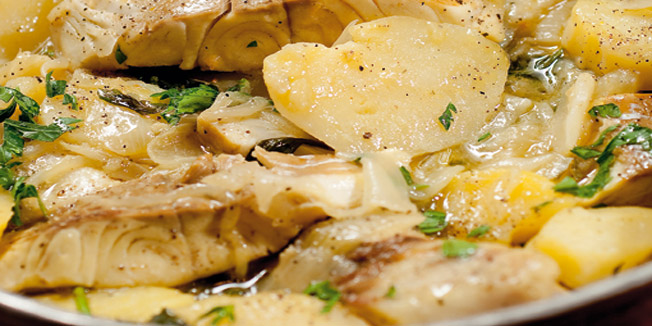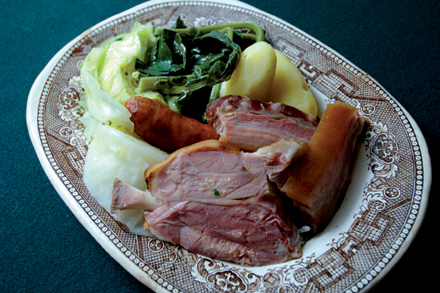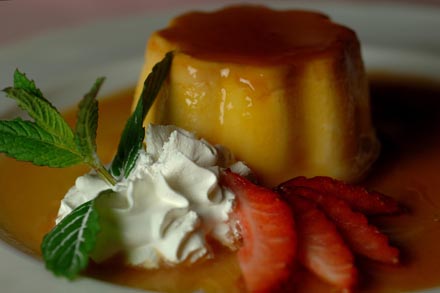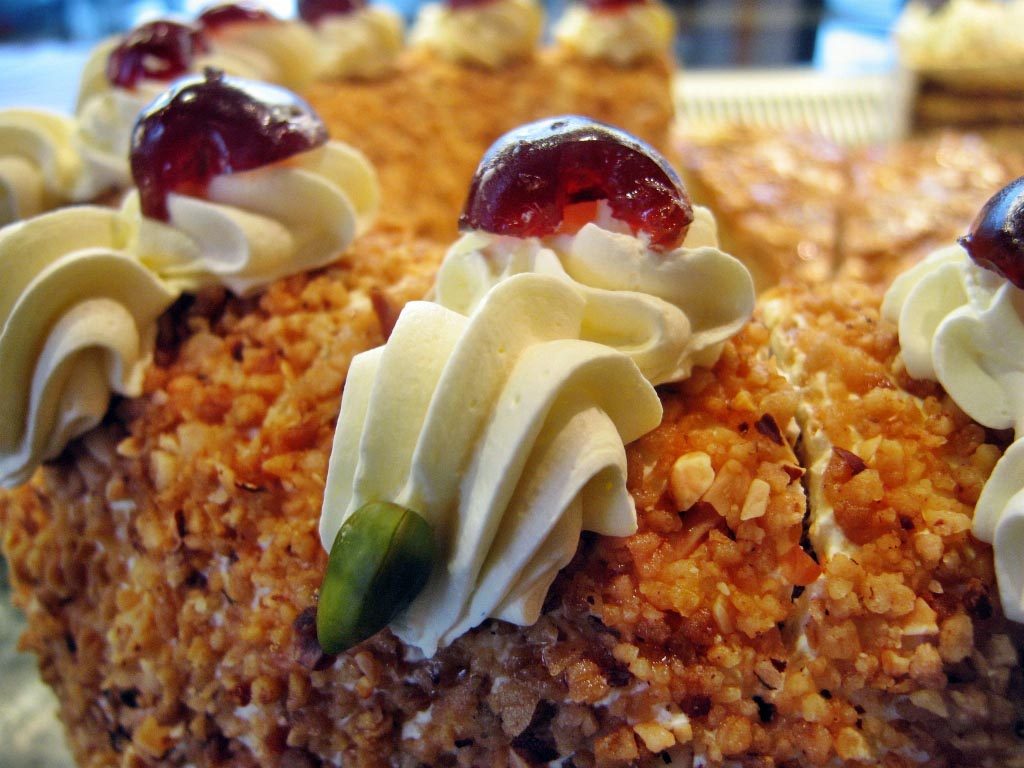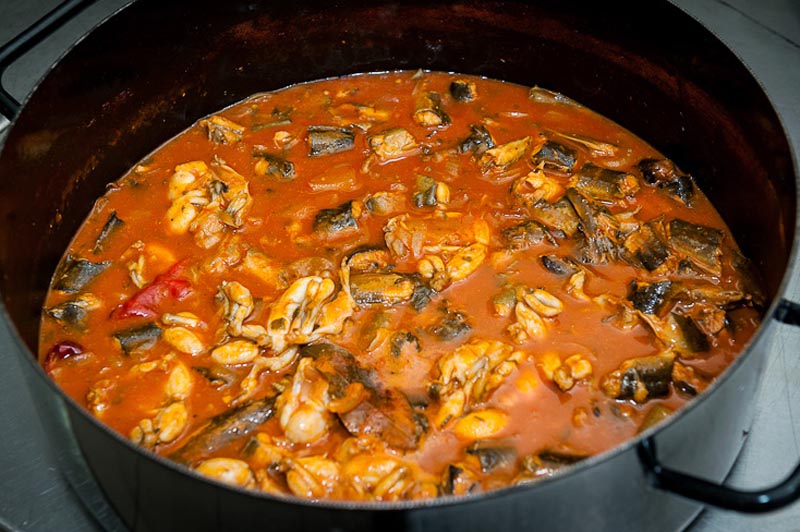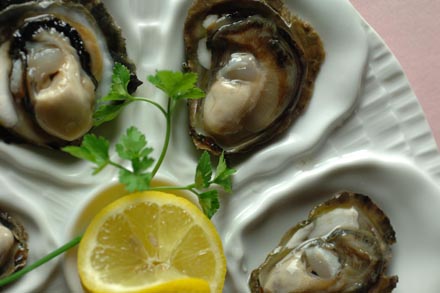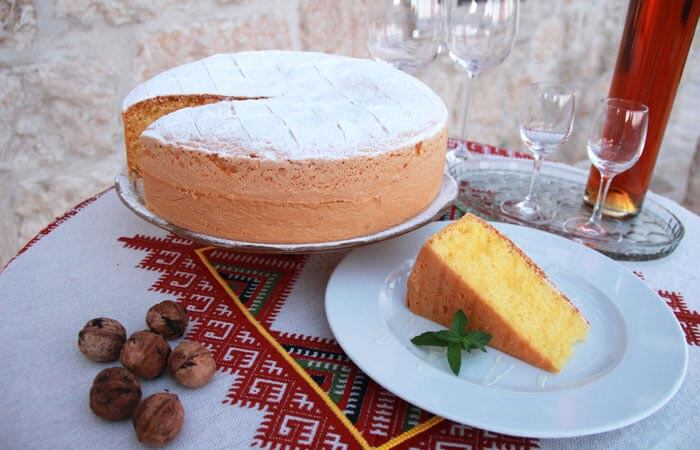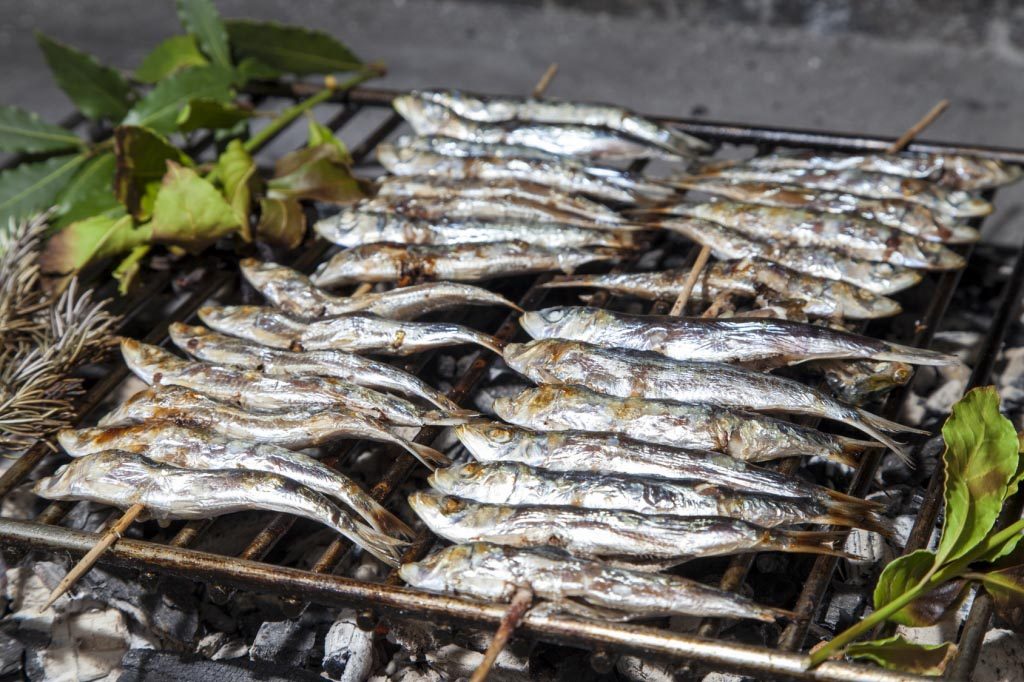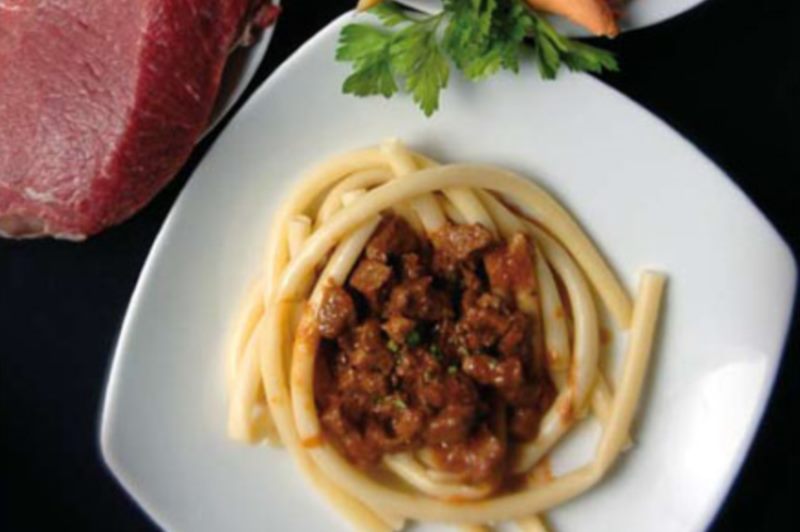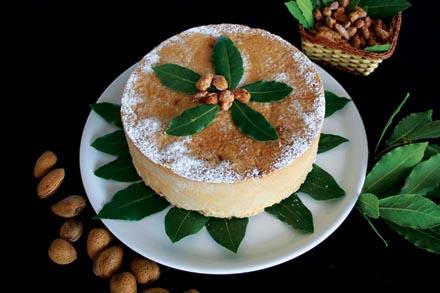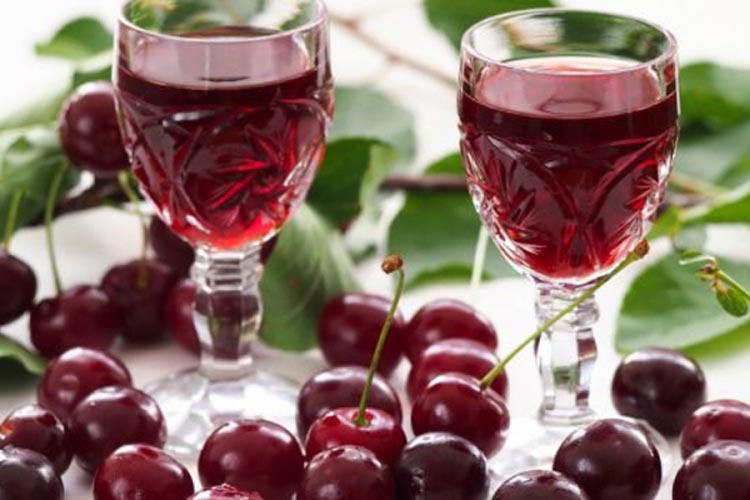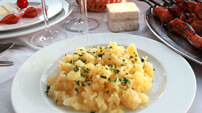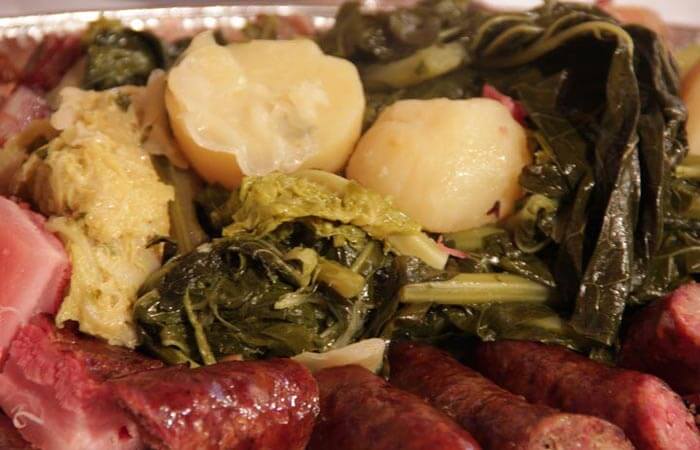Gastronomy
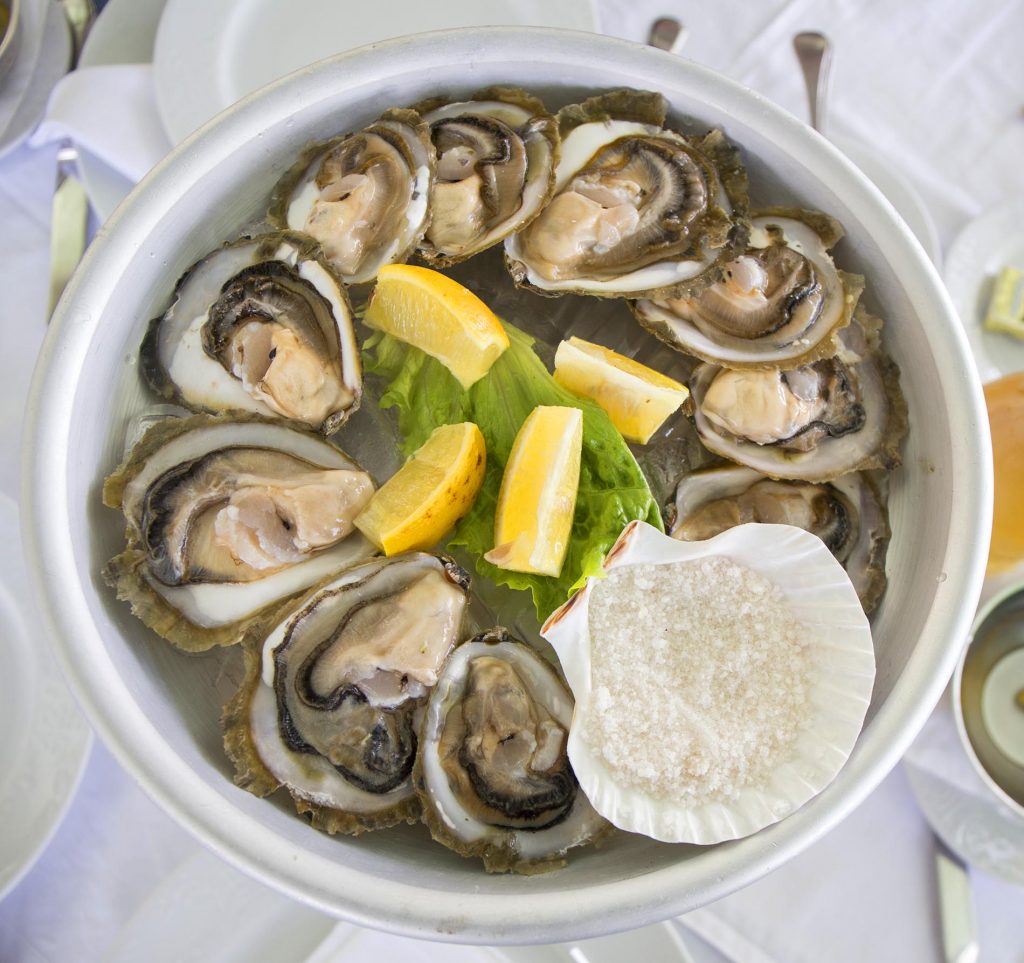 The rich and diverse culinary tradition of our County is certainly one of the most important factors in our tourism offer.
The rich and diverse culinary tradition of our County is certainly one of the most important factors in our tourism offer.
A healthy and delicious bite is best accompanied by one of the excellent wines of the Pelješac peninsula. Despite its rocky environment, Pelješac is home to many wine growers and farmers who, with their hard work, have succeeded in maintaining the fertile soil where vegetables and fruits are grown, as are the world renowned Dingač and Postup wines. Tasting these high quality autochthonous wines is a must for all those visiting the region, and bottles of Dingač and Postup are among most significant souvenirs and gift which will delight any wine lover.
The well known wines of the island of Korčula are: Grk, Pošip and Rukatac (Maraština).
Our valued Konavle, with its richly set table offers the delicacies of this region: kontonjata (cooked dessert made of quince), mantala (cooked dessert made of must, carob and walnuts) and arancina (sugared orange peels) with the aromatic herb brandy travarica and grape brandy lozovača and a drop of the good quality wines from Konavle and Malvasija from Dubrovnik.
The culinary walk through the County can begin in the numerous restaurants and taverns in the Neretva Valley, where you will find eel and frog stew, delicious game dishes and the special wild duck (liska). From here, our path takes us to Ston, where you certainly will not be able to resist the fresh oysters, mussels and freshly prepared fish.
Continue on to the island of Korčula, where you can enjoy the typical dishes of the tourist towns of this beautiful island served in the numerous taverns and restaurants.
On the islands of Mljet, Šipan, Lopud and Koločep, enjoy dishes made from dried fish or seafood, while the restaurants of Župa Dubrovnik and Konavle offer prosciutto, cheese in oil, zelena menestra (meat and cabbage stew) and other delicacies.
- All
- Fish
- Meat
- Savory
- Sweet
- Vege
Irresistible desserts from southern Croatia you shouldn’t skip
No meal is complete without a sweet bite, so the renowned savoury delicacies of the Dubrovnik-Neretva County also need their “finale” in the form of dessert. It is often said that calories don’t count on vacation and that dessert goes straight to the heart, which is bound to happen if you try some of the sweet treats from Dubrovnik.
What all of the desserts from the Dubrovnik-Neretva region have in common is the way they are prepared – locally-sourced ingredients and traditional techniques are used in all of them, and they are all part of a rich tradition dating back centuries. This is why these desserts are so much more than a sweet end to a meal – their flavours tell authentic stories of this unique corner of the Mediterranean, and our cuisine is highly diverse. Desserts are dominated by distinctive ingredients, such as oranges and almonds, giving them a specific flavour and texture. They are guaranteed to be a culinary delight fit for even the most demanding taste buds, and at the same time they are a piece of a tremendous heritage.
Desserts characteristic of the Dubrovnik-Neretva County
All dessert stories begin with the rozata, a creamy custard cake reminiscent of pudding. This culinary symbol is a staple at many restaurants in Dubrovnik, and you only need a bit of skill and precision to recreate it at home, using this tried and tested recipe.
If you want to take a piece of your southern holiday home with you, you can’t go wrong with arancini. As their name suggests, they are usually made with oranges, but they are just as delicious if you use the rind of some other citrus fruit, such as lemons or grapefruit. The refreshing arancini are best enjoyed with a cup of coffee or tea. They can also be a wonderful souvenir – a bag filled with the distinctive flavour of the rich culinary tradition of southern Croatia. If you’d like to try and make them yourself, try this recipe.
Dried figs are another fruity dessert with a long-standing tradition in local cuisine. They are sun-dried, allowing them to retain their inherent sweetness and juiciness, and they can be enjoyed as-is, or combined with nuts, honey and cheese, creating the perfect balance of sweet and savoury. A bag of dried figs is also a great souvenir for any foodie in your life.
If you were to ask locals for some dessert recommendations, you would definitely hear the name krokant. Another part of our tradition, it is special because you only need three ingredients to make it – sugar, peeled almonds and water. Krokant may be simple to make, but its flavour is delightfully rich. Almonds guarantee an opulent taste, and just like the arancini, this dessert is the ideal pairing for a cup of your favourite hot beverage. It is also popular as a sweet souvenir because every box of krokant, available in many sweet shops and food stores, makes it possible for our visitors to relive their holiday for a long time.
Should you venture outside of the city, you’re sure to find even more unique desserts. When it comes to somewhat unusual, but extremely delicious, recipes, look no further than the Ston cake with makaruli, where the main role is played by – macaroni. This atypical ingredient is what gives the cake its specific texture, and anyone who tries it is surprised by its flavour. The macaroni, or makaruli, is paired with traditional ingredients from the region – almonds, walnuts, lemons, … This dessert is typical for Pelješac, but it is enjoyed in the entire Dubrovnik-Neretva region.
Cake fans will be happy to hear of another lovely dessert – the padišpanj or sponge cake, which pairs wonderfully with prošek. This cake dates back to ancient times, and its special for its simplicity, as it requires only three very “ordinary” ingredients – eggs, sugar and flour. The cake is most often served at weddings, and it was brought to southern Croatia by sailors from Spain.
If you want to taste the true aromas of the island of Korčula, make sure you try the lumblija, one of the traditional island cakes. Walnuts, almonds, raisins, lemon, orange and various spices all come together to give it its traditional flavour, while the special ingredient is varenik, a reduced wine must characteristic of the old times, when it was used as a sweetener.
Desserts from southern Croatia vary greatly – from the rich delicacies with countless ingredients, to the equally delicious bites made with only three or four ingredients. One such dessert is the kotonjata, a sweet jelly made with quince, sugar and lemons. Once cooled, it has a distinct sweetness, and it is reminiscent of the tradition and wealth of the local flavours.
We have included only some of the dishes typical for the cuisine of the Dubrovnik-Neretva region. One thing is for sure: once you try one of these desserts, you won’t stop there. The sweet traditional flavours and the authentic stories behind each of them will be calling your name!
Eels and frogs – authentic gastronomy worth a try in the Neretva river valley
If you find yourself in the area affectionately known as the “California of Croatia”, dare to try eels and frogs, ingredients characteristic of the Neretva region. They have been present in the area for centuries so the recipes have certainly been perfected, as confirmed by happy visitors who often ask for seconds.
The Neretva valley has become a popular vacation spot for adrenaline junkies thanks to its wide delta, and it is often referred to as the “California of Croatia”. Kitesurfing enthusiasts can enjoy the wind and the sea, but if adrenaline sports aren’t your thing, the Neretva delta is known for its extraordinarily diverse nature, which is definitely worth travelling to the very south of Croatia. The spot where the Neretva river meets the Adriatic Sea is unique for its gorgeous and abundant nature, while the fertile river provides ideal conditions for agricultural activities, which in turn leads to amazing gastronomy. The area is renowned for its excellent cuisine: first and foremost, there are the mandarin oranges, figs, watermelons and other fruit as a tasty preface to some very special delicacies, authentic specialties of the Neretva valley, eels and frogs.
Eels and frogs are the most famous delicacies of the Neretva region
Every visit to the Neretva valley should be accompanied by special gastronomy experiences. Why eels and frogs? Although these delicacies aren’t the first choice of all visitors, they are certainly worth a try as they are the most famous traditional dishes of this region. Frogs have been enjoyed here since ancient times, and they were once a food for the poor, but today they are at the top of the recommendations for anyone searching for the typical flavours of the Neretva valley.
The abundant wetland habitats in the area are conducive to large numbers of eels and frogs, so it comes as no surprise that these two species have been an essential part of the local cuisine for centuries. However, they aren’t enjoyed only by the locals – visitors to the Neretva valley are also on the lookout for the best delicacies offered.
It seems to us that every chef has their own recipe. Everyone has their own way of preparing them, but one that is especially well-known is the Neretva eel and frog brodetto. Brudet, brodet, brujet – call it what you want, but they all taste amazing, and are sure to satisfy even the biggest gourmands out there. Although every town and village has its own recipe, all of them include freshly caught eels and frogs, with added onions, garlic, tomato and various herbs. The flavour is enhanced by adding some wine. The eel and frog brodetto is served with polenta, and as it is prepared with fresh ingredients and seasoned to perfection, it guarantees a rich combination of flavours which will keep you wanting more. Its importance is proved by the fact that the brodetto has been included in the list of protected intangible cultural heritage of the Republic of Croatia.
The eel and frog brodetto is not the only delicacy you need to try when you visit the Neretva valley. Fried frog legs are considered another specialty of the Neretva region. They taste very similar to chicken, and their juiciness is the result of a marinade made from lemon juice, olive oil, salt and pepper. This local delicacy is the best when accompanied by some polenta, or in the simplest way possible – with some bread and a glass of good wine.
Another traditional recipe which differs slightly from one household to the next is that for spit-roasted eels, a popular way to prepare this traditional ingredient. This is another dish where a simple, but special, marinade has a crucial role, and it is prepared with olive oil, white wine, garlic and spices. The result is a crispy and delicious dish, and once you’ve tried it you’ll probably ask for more.
The menu typical of the Neretva valley shows that this region offers more than adrenaline thrills and beautiful nature – you’ll also encounter a gastronomy adventure just as exciting as the scenery surrounding it. So, even if you aren’t sure that eels and frogs are ingredients you’d like to see on your plate, be brave and discover these new delicacies and they will take you to a special journey through the land of amazing flavours.
Unique and delicious fish dishes in the Dubrovnik-Neretva County
Fish and seafood dishes in the Dubrovnik-Neretva County are prepared according to some of the best recipes, whose tradition dates back decades or, in some cases, even centuries. As an essential part of the Mediterranean diet, fish has had its place on the local tables since ancient times, and today it is also the favourite among visitors in search of authentic flavours from the sea.
Fantastic fish dishes, especially seafood, are at the heart of the gastronomy of southern Croatia. Not only are the fish and seafood a crucial part of the tourist offer, they are a part of the centuries long tradition of the local population, that has managed to preserve these unique recipes passing them down from one generation to the next.
It should be noted that fishery has deep roots in our regional culture. The wealth of gifts from the sea has enabled the local population to make fish and seafood the staple of its dinner table. Today, the fishery tradition is the backdrop for the sophisticated gastronomy of Dubrovnik, its surrounding area, the islands and the Neretva valley. These fish dishes will win you over with their rich flavours and methods of preparation, as well as their stories, since they have always been a part of life and customs of the local population.
Which fish dishes are the most authentic?
Let’s start with a fairly simple, but extremely popular fish dish, sure to make your mouth water – grilled skewered sardines. The secret to their fantastic flavour is the simplicity – not only do they need just a few minutes to cook, you also don’t need use anything else with them but some coarse salt. It also doesn’t require any elaborate side dishes, so it’s best enjoyed with a piece of freshly baked bread, some refreshing greens, and the inevitable glass of your favourite wine. The simplicity of this method enables the natural flavours of the fish to be in the spotlight, without any need for various spices.
Speaking of simple dishes, we have to mention mussels à la buzara. Mussels combined with olive oil, parsley, garlic, wine and some spices are beloved not only for their flavours and aromas, but also their simple and quick preparation. Mussels à la buzara bring a dash of Mediterranean tradition to the plate, so the locals are always happy to make it for the tourists, who are always happy to try some.
A dish full of rich, and yet refreshing and remarkable flavours is the light and delicious octopus salad, the perfect choice on a hot summer day. Octopus has a specific texture and a distinctive aroma, and anyone can add to it as they wish. It is usually served with potatoes and tomatoes, and if you want to emphasise its unique flavours, it’s best to add some amazing Mediterranean herbs and spices – bay leaf, onions, garlic, lemon juice, olive oil, salt, pepper…
It’s not uncommon for dishes which were once a poor man’s food to turn into a genuine delicacy. This happened to the cod, a fish with a festival dedicated to it in Dubrovnik. It takes place in December, as this famous fish delicacy is traditionally enjoyed around Christmas and the New Year. Although cod fish isn’t present in the Adriatic Sea, it is a very popular fish dish here. As is the case with most dishes cooked up by our grandmas, there are countless ways to prepare it, such as brodetto, seaman’s cod, grilled, with a side of polenta, etc. It should be noted that cod has outstanding nutritional values, it is considered an excellent low-calorie source of protein, and it is recommended for heart disease prevention. You can find some recipes showcasing the cod fish here.
One of the dishes extremely popular with our visitors is the black risotto, whose unusual appearance comes from the ink of a cuttlefish or squid, which are at the centre of this delicious dish. This dish combines the maritime tradition and fresh, locally-sourced ingredients. The fish and seafood are what gives the risotto its creaminess, making it one of the dishes you simply must try.
While we are on the topic of fish delicacies, we simply cannot skip the oyster. This mollusc is especially popular in the Bay of Mali Ston on Pelješac, an area with the ideal conditions for their cultivation. They are delicious in any form, and especially these two: in a soup and in their simplest form – as is, with just a bit of lemon juice. The oyster soup is a traditional dish with a completely opulent flavour, and it is served warm, with a simple parsley garnish. This salty soup pairs excellently with a glass of white wine, which is also used in its preparation. Oyster should definitely be tasted in their most basic form – completely fresh, sprinkled with just a few drops of lemon juice. This brings out their rich flavour and their specific texture, which makes them one of the most famous delicacies of the Dubrovnik-Neretva region.
The Neretva valley is renowned for its specialty, the eel and frog brodetto. Ingredients which put this area on the culinary map have a long-standing tradition. The flavours in this brodetto are intense, and it is usually served with polenta, which brings the perfect balance to its richness.
Meat delicacies of the Dubrovnik-Neretva County: Explore the rich offer of fantastic dishes
They may not be as popular as fish dishes, but meat delicacies from southern Croatia hold some of the most authentic flavours of our region. Their history spans generations who have been combining locally sourced ingredients and applying traditional methods of preparation, making them an essential part of a gastronomy tour of the south.
The first thing that comes to mind when we think of gastronomy in the Dubrovnik-Neretva County are fish and seafood, but there are numerous meat delicacies which show that southern Croatia has an excellent offer for meat lovers as well; namely, several amazing dishes whose recipes have been passed down from one generation to the next for decades. These meat dishes combine the finest locally-sourced ingredients with traditional methods of preparation, leading to amazing results sure to satisfy even the biggest gourmands.
Which meat dishes are the most popular?
All the dishes have rich flavours, and among the most popular are the green menestra, sporchi (dirty) macaroni, and meat roasted under the peka.
The green menestra is prepared in several ways, which means that every village has their own recipe. What they all have in common is a centuries old tradition as one of the most popular dishes of the Dubrovnik nobility. The green menestra is always on the menu at Christmas, but it is also prepared for various celebrations. It’s special because it is made from various kids of greens (collard greens, kale, cabbage) and several types of meat, including cured pork, sheep and homemade cured sausage. Here are the recipes for two versions of the green menestra: one from Dubrovnik and one from Konavle, where menestra is presumed to have originated.
Another local dish popular particularly in colder, winter days are the sporchi macaroni. This is a pasta dish with meat sauce, a delicacy traditionally prepared for the Saint Blaise festivities. Even though it’s considered a festive dish, it is always a welcome guest at the dining table, and its recipe has been passed down from one generation to the next for centuries. There is an interesting story attached to its name. The most sought-after part of the dish is, of course, the sauce, because it contains meat. Once the meat sauce is gone, the guests who are the last ones at the meal only get to eat the remaining pasta – macaroni stained with some leftover sauce, making them “dirty”.
Although the islands are primarily known for their fish specialties, we have to mention Korčula and their unique dish, the škopčevina, made with the meat of a castrated male goat. It was considered a poor man’s food a long time ago, and now it’s a popular tradition.
Another interesting and very popular dish is the kopun (rooster), a poultry delicacy which has been a part of the local gastronomy for centuries. It is an essential part of any dining table around the holidays and important family gatherings, and it is popular among tourists as it brings a dose of tradition and authenticity to the table. The kopun is juicy and crispy on the outside, soft on the inside, and it owes its rich flavour to high-quality meat and a marinade made with a mixture of spices, herbs and oil.
Last, but not least, one of the most authentic and most popular dishes – the peka. The tradition of roasted meat is especially popular around the holidays, but it is prepared throughout the year. The types of meat used most often are veal, suckling pig and lamb, combined with potatoes and other vegetables, such as carrots, peppers, onion, garlic… This isn’t a quick meal, as the roasting lasts several hours, but it is well worth the wait because the finished product is a juicy cut of meat with crispy potatoes and aromatic vegetables.
These various meat dishes prove that meat-lovers are sure to find something for themselves, even though fish dishes are more popular, making our region an excellent spot for adventures in gastronomy.
The unforgettable and unique gastronomy of the island cuisines of Korčula, Lastovo and Mljet
The islands, whose culinary offer greatly contributes to the diversity of the gastronomy in our region, play a big role in the varied offer of the Dubrovnik-Neretva County. This is primarily true of the largest islands in the county – Korčula, Lastovo and Mljet – places attracting tourists with their mesmerising beauty, as well as a unique culinary experience. The island cuisine is extremely enticing for all foodies, thanks to the story behind the delicious dishes, as well as the rich history and culinary tradition.
Although the cuisine of the islands of Mljet, Korčula and Lastovo includes some contemporary and new dishes, the traditional local cuisine is still being preserved, and it is based on recipes passed from one generation to the next for decades, or even centuries. It focuses on various fish dishes and seafood, always paired with a glass of top-quality wine, creating a rhapsody of flavours sure to satisfy even the most demanding gourmands.
Once you’ve arrived to any of these three gorgeous islands, you set off on a journey through their gastronomy, where you will discover some amazing savoury and sweet dishes. They are all bursting with rich flavours and aromas, as well as a centuries old tradition, which makes this culinary story so special.
The cuisine of Korčula
Let’s start with some olive oil – it may not be a dish, but it is the essential element in many recipes. To understand how important olive growing is, all you need to know is that there are hundreds of holdings involved in cultivating olives. The slight fruity aroma and a perfect golden colour of the oil make it the ideal addition to any fish dish, salad or simple bread for dipping.
Korčula is known for some extraordinary delicacies, most notably fish and seafood. From the simplest grilled fish, to juicy octopus prepared in its own juices, or the amazing brodetto. Its Korčula version is called popara and it is basically a fish stew, a traditional dish made with small fish, soup and a side of potatoes.
Meat lovers won’t stay hungry for long, mostly thanks to the most famous meat dishes from Korčula – the žrnovski makaruni and the beloved pašticada with gnocchi. The recipe for preparing the long and thin macaroni pasta has been passed down from one generation to the next, and they were nicknamed “žrnovski” from the village they hail from: Žrnovo. They are normally served with beef, which allows them to pair wonderfully with some red wine, žrnovski makaruni are just as delicious with some salsa. Also, don’t miss škopčevina, a dish that might not be up everyone’s alley, but once you’ve tried it, you’ll love the traditional manner of preparing of this meat from a castrated male goat, best when grilled. Another island specialty is the pašticada with gnocchi, enjoyed throughout Dalmatia. If prepared properly (a long cooking time is a part of the Korčula recipe), it melts in the mouth. Its layered and rich aromas combine all of the flavours of Korčula, bringing you the finest of its gastronomy heritage.
Nothing follows these savoury dishes better than a good sweet treat, and Korčula has a lot to offer in this department: lumblije, spomilje, cukarini, amareti and klašuni.
No gastronomy story is complete without wine, so the renowned wines from Korčula are the best accompaniment for any dish. When it comes to white wine, you can’t go wrong with Pošip, Rukatac and Grk, while the most famous red wine is the Plavac Mali.
The cuisine of Lastovo
The story of food on Lastovo also begins with the olive oil. The island cuisine is just as appealing to fish lovers as to those who prefer meat, and dishes from Lastovo are based on gifts from the sea and locally-sourced ingredients. Freshness, authenticity and local sourcing are the best words to describe the rich and diverse gastronomy of Lastovo, enabling visitors to try some traditional and authentic flavours.
First class fish is the staple on the menus of various taverns: grilled sardines, scorpion fish brodetto, fish in white sauce, lobster with pasta, conger brodetto, and grilled moray are just some of the most popular dishes from the sea. The simplest and probably one of the most delicious dishes is grilled sardines, which were, according to some, first prepared precisely on Lastovo. The original recipe calls for completely cleaned sardines, without heads and entrails. What the sardines, as well as all other island delicacies, have in common is their freshness. The locals are well-aware that the dish tastes the best when made with freshly caught fish, and they want all of their visitors to experience this.
Although the gastronomy of the island is pretty much fish-based, there are various meat delicacies offered at numerous holdings to satisfy any meat lover. They are primarily prepared with chicken, goat and lamb, and just like in the fish dishes, it’s all about preserving the rich gastronomy heritage of the island, inviting everyone to enjoy the authentic, freshly prepared food.
The Mediterranean flavours of Lastovo are also nicely experienced through its offer of sweet treats. At the end of your restaurant experience, make sure to try some of the typical Lastovo desserts, such as skalice, prkle, kotonjata and arancini. The wine list resembles that of the other islands in the Dubrovnik-Neretva County, so the indigenous varieties are the Rukatac, Maraština and Plavac Mali, all perfect additions to any island meal.
The cuisine of Mljet
The greenest Croatian island also boasts an exquisite cuisine, and its restaurants and taverns base their menus on a long-standing tradition centred on plenty of fish and seafood.
This includes a somewhat unusual island dish – eels, abundant on the island thanks to three mudflats (blatine) on Mljet, that are sources of brackish water. Regardless of their preparation, grilled or in brodetto, eels are an island delicacy sure to entice any gourmand.
There are also other species of fresh fish, whose flavour is more so enhanced with top-quality olive oil, given the centuries-long tradition of olive cultivation on the island.
The local cuisine also offers several meat delicacies, especially those prepared with goat meat. Goat is a distinguished delicacy thanks to its special aroma and texture, and pairs particularly well with the aromatic herbs abundant on the island. Goats give us another delicacy – goat cheese, known for its rich aroma. Goat milk used for the production of this goat cheese, considered a true culinary treasure, has a distinctive taste due to the free range of the goats on the island. Many island delicacies are made with game meat – wild boars, rabbits, deer and mouflon – given that the lush forests around the island are inhabited by various game species. Their meat has a specific and intense flavour, and it tastes best when marinated in Mediterranean herbs.
After all of these savoury specialties, there’s nothing better than a sweet morsel, and the main role in the island desserts is played by simple and traditional ingredients, such as figs, almonds and carob, all known for their rich taste. Lastly, everything tastes better with a glass of exquisite wine, whose quality is the result of sunshine and close proximity to the sea. Pošip and Rukatac are the most common white wines, while the most popular red is the Plavac Mali.
Why is olive oil more than just an ingredient? It is a symbol of tradition, history and health, and is a popular souvenir
Precious, opulent, healthy, indigenous… Just a few adjectives to describe olive oil, an essential part of the gastronomy in the Dubrovnik-Neretva region. The olive is a valued produce in itself and it has had a place at local dining tables since ancient times, making it an invaluable part of the heritage in these areas.
Before we start talking about olive oil as an unbelievable link between nature and humanity, and a very popular portion of the tourist offer today, it is important to mention all of its health benefits. Olive oil is at the very centre of the Mediterranean diet, also called the “golden standard for the heart”, as it is balanced and beneficial for the body. There is a wide range of benefits to consuming olive oil, such as the fact that it is rich in healthy fatty acids, vitamins and antioxidants, and consuming it in moderation you can achieve various health benefits – from your digestive tract, to your immune system and your heart.
The olive and olive oil are a symbol of dedication, effort and hard work
Throughout the centuries, olive oil has become more than just a healthy addition to food. Today it is distinctive symbol of the Dubrovnik-Neretva region, with a long history of production, whose reputation goes beyond being just a food product. Olive oil tells stories of history and tradition, as its production in this region is deeply rooted in the lives of the local people. This dedication of olive growers, their love of the fruit borne by the olive tree, is ingrained in every single drop of this oil.
Away from the kitchen and the dining table, the unique properties of olive oil have been long-known to visitors to the south of Croatia, making it an important part of the tourist offer. Even though it is not a dessert, it’s clear that the “sweetest” part of every meal is dipping bread in olive oil when starting your meal, as it is the perfect way to taste it in all of its glory.
Our visitors enjoy the rich taste, and they want to know more about the story behind our olive oil. The story of the origins of olive oil, where carefully harvested olives are later processed in oil mills, is highly requested by many visitors.
If you have ever participated in an olive harvest, you know it’s about more than just harvesting. The days of harvest are eagerly anticipated, carefully prepared, and they are when families and friends come together. Olive harvesting is always accompanied by a sense of togetherness, laughter and delicious food, making it an important part of tradition and family heritage. This activity connects generations as every family member, from the youngest to the oldest, has their own task. Olive harvesting may be a tedious task, but nobody sees it as such since it is a way of preserving tradition and making special memories. Our visitors can now make these memories themselves. This is possible thanks to numerous local producers whose family history includes olive oil production, so tastings, visits to olive groves, and first-hand experience are now an essential part of the tourist offer in our region.
Olive oil tastings are an excellent way to get some insight into the fascinating world of olive growing. It shows that every drop of oil made from different olive varieties tells a unique story, and a visit to an olive grove is a wonderful way to experience the process behind producing this “liquid gold”, as olive oil is fondly known. Gorgeous and resplendent golden shades and the rich aroma of olive oil will take your taste buds on a unique journey.
Professionals are happy to share some small secrets for using olive oil in your kitchen every day. These valuable pieces of advice will be the most cherished souvenir from your holiday, and if you’d prefer something more “tangible”, there’s no better gift than a bottle of olive oil. That way you can take home a bit of the indigenous aromas of our region and enjoy its benefits for a long time. Just one bottle is enough to encompass our culture, our most amazing aromas and the most authentic memory of your visit to this special place.
- Desserts
-
Irresistible desserts from southern Croatia you shouldn’t skip
No meal is complete without a sweet bite, so the renowned savoury delicacies of the Dubrovnik-Neretva County also need their “finale” in the form of dessert. It is often said that calories don’t count on vacation and that dessert goes straight to the heart, which is bound to happen if you try some of the sweet treats from Dubrovnik.
What all of the desserts from the Dubrovnik-Neretva region have in common is the way they are prepared – locally-sourced ingredients and traditional techniques are used in all of them, and they are all part of a rich tradition dating back centuries. This is why these desserts are so much more than a sweet end to a meal – their flavours tell authentic stories of this unique corner of the Mediterranean, and our cuisine is highly diverse. Desserts are dominated by distinctive ingredients, such as oranges and almonds, giving them a specific flavour and texture. They are guaranteed to be a culinary delight fit for even the most demanding taste buds, and at the same time they are a piece of a tremendous heritage.
Desserts characteristic of the Dubrovnik-Neretva County
All dessert stories begin with the rozata, a creamy custard cake reminiscent of pudding. This culinary symbol is a staple at many restaurants in Dubrovnik, and you only need a bit of skill and precision to recreate it at home, using this tried and tested recipe.
If you want to take a piece of your southern holiday home with you, you can’t go wrong with arancini. As their name suggests, they are usually made with oranges, but they are just as delicious if you use the rind of some other citrus fruit, such as lemons or grapefruit. The refreshing arancini are best enjoyed with a cup of coffee or tea. They can also be a wonderful souvenir – a bag filled with the distinctive flavour of the rich culinary tradition of southern Croatia. If you’d like to try and make them yourself, try this recipe.
Dried figs are another fruity dessert with a long-standing tradition in local cuisine. They are sun-dried, allowing them to retain their inherent sweetness and juiciness, and they can be enjoyed as-is, or combined with nuts, honey and cheese, creating the perfect balance of sweet and savoury. A bag of dried figs is also a great souvenir for any foodie in your life.
If you were to ask locals for some dessert recommendations, you would definitely hear the name krokant. Another part of our tradition, it is special because you only need three ingredients to make it – sugar, peeled almonds and water. Krokant may be simple to make, but its flavour is delightfully rich. Almonds guarantee an opulent taste, and just like the arancini, this dessert is the ideal pairing for a cup of your favourite hot beverage. It is also popular as a sweet souvenir because every box of krokant, available in many sweet shops and food stores, makes it possible for our visitors to relive their holiday for a long time.
Should you venture outside of the city, you’re sure to find even more unique desserts. When it comes to somewhat unusual, but extremely delicious, recipes, look no further than the Ston cake with makaruli, where the main role is played by – macaroni. This atypical ingredient is what gives the cake its specific texture, and anyone who tries it is surprised by its flavour. The macaroni, or makaruli, is paired with traditional ingredients from the region – almonds, walnuts, lemons, … This dessert is typical for Pelješac, but it is enjoyed in the entire Dubrovnik-Neretva region.
Cake fans will be happy to hear of another lovely dessert – the padišpanj or sponge cake, which pairs wonderfully with prošek. This cake dates back to ancient times, and its special for its simplicity, as it requires only three very “ordinary” ingredients – eggs, sugar and flour. The cake is most often served at weddings, and it was brought to southern Croatia by sailors from Spain.
If you want to taste the true aromas of the island of Korčula, make sure you try the lumblija, one of the traditional island cakes. Walnuts, almonds, raisins, lemon, orange and various spices all come together to give it its traditional flavour, while the special ingredient is varenik, a reduced wine must characteristic of the old times, when it was used as a sweetener.
Desserts from southern Croatia vary greatly – from the rich delicacies with countless ingredients, to the equally delicious bites made with only three or four ingredients. One such dessert is the kotonjata, a sweet jelly made with quince, sugar and lemons. Once cooled, it has a distinct sweetness, and it is reminiscent of the tradition and wealth of the local flavours.
We have included only some of the dishes typical for the cuisine of the Dubrovnik-Neretva region. One thing is for sure: once you try one of these desserts, you won’t stop there. The sweet traditional flavours and the authentic stories behind each of them will be calling your name!
- Eels and frogs
-
Eels and frogs – authentic gastronomy worth a try in the Neretva river valley
If you find yourself in the area affectionately known as the “California of Croatia”, dare to try eels and frogs, ingredients characteristic of the Neretva region. They have been present in the area for centuries so the recipes have certainly been perfected, as confirmed by happy visitors who often ask for seconds.
The Neretva valley has become a popular vacation spot for adrenaline junkies thanks to its wide delta, and it is often referred to as the “California of Croatia”. Kitesurfing enthusiasts can enjoy the wind and the sea, but if adrenaline sports aren’t your thing, the Neretva delta is known for its extraordinarily diverse nature, which is definitely worth travelling to the very south of Croatia. The spot where the Neretva river meets the Adriatic Sea is unique for its gorgeous and abundant nature, while the fertile river provides ideal conditions for agricultural activities, which in turn leads to amazing gastronomy. The area is renowned for its excellent cuisine: first and foremost, there are the mandarin oranges, figs, watermelons and other fruit as a tasty preface to some very special delicacies, authentic specialties of the Neretva valley, eels and frogs.
Eels and frogs are the most famous delicacies of the Neretva region
Every visit to the Neretva valley should be accompanied by special gastronomy experiences. Why eels and frogs? Although these delicacies aren’t the first choice of all visitors, they are certainly worth a try as they are the most famous traditional dishes of this region. Frogs have been enjoyed here since ancient times, and they were once a food for the poor, but today they are at the top of the recommendations for anyone searching for the typical flavours of the Neretva valley.
The abundant wetland habitats in the area are conducive to large numbers of eels and frogs, so it comes as no surprise that these two species have been an essential part of the local cuisine for centuries. However, they aren’t enjoyed only by the locals – visitors to the Neretva valley are also on the lookout for the best delicacies offered.
It seems to us that every chef has their own recipe. Everyone has their own way of preparing them, but one that is especially well-known is the Neretva eel and frog brodetto. Brudet, brodet, brujet – call it what you want, but they all taste amazing, and are sure to satisfy even the biggest gourmands out there. Although every town and village has its own recipe, all of them include freshly caught eels and frogs, with added onions, garlic, tomato and various herbs. The flavour is enhanced by adding some wine. The eel and frog brodetto is served with polenta, and as it is prepared with fresh ingredients and seasoned to perfection, it guarantees a rich combination of flavours which will keep you wanting more. Its importance is proved by the fact that the brodetto has been included in the list of protected intangible cultural heritage of the Republic of Croatia.
The eel and frog brodetto is not the only delicacy you need to try when you visit the Neretva valley. Fried frog legs are considered another specialty of the Neretva region. They taste very similar to chicken, and their juiciness is the result of a marinade made from lemon juice, olive oil, salt and pepper. This local delicacy is the best when accompanied by some polenta, or in the simplest way possible – with some bread and a glass of good wine.
Another traditional recipe which differs slightly from one household to the next is that for spit-roasted eels, a popular way to prepare this traditional ingredient. This is another dish where a simple, but special, marinade has a crucial role, and it is prepared with olive oil, white wine, garlic and spices. The result is a crispy and delicious dish, and once you’ve tried it you’ll probably ask for more.
The menu typical of the Neretva valley shows that this region offers more than adrenaline thrills and beautiful nature – you’ll also encounter a gastronomy adventure just as exciting as the scenery surrounding it. So, even if you aren’t sure that eels and frogs are ingredients you’d like to see on your plate, be brave and discover these new delicacies and they will take you to a special journey through the land of amazing flavours.
- Fish dishes
-
Unique and delicious fish dishes in the Dubrovnik-Neretva County
Fish and seafood dishes in the Dubrovnik-Neretva County are prepared according to some of the best recipes, whose tradition dates back decades or, in some cases, even centuries. As an essential part of the Mediterranean diet, fish has had its place on the local tables since ancient times, and today it is also the favourite among visitors in search of authentic flavours from the sea.
Fantastic fish dishes, especially seafood, are at the heart of the gastronomy of southern Croatia. Not only are the fish and seafood a crucial part of the tourist offer, they are a part of the centuries long tradition of the local population, that has managed to preserve these unique recipes passing them down from one generation to the next.
It should be noted that fishery has deep roots in our regional culture. The wealth of gifts from the sea has enabled the local population to make fish and seafood the staple of its dinner table. Today, the fishery tradition is the backdrop for the sophisticated gastronomy of Dubrovnik, its surrounding area, the islands and the Neretva valley. These fish dishes will win you over with their rich flavours and methods of preparation, as well as their stories, since they have always been a part of life and customs of the local population.
Which fish dishes are the most authentic?
Let’s start with a fairly simple, but extremely popular fish dish, sure to make your mouth water – grilled skewered sardines. The secret to their fantastic flavour is the simplicity – not only do they need just a few minutes to cook, you also don’t need use anything else with them but some coarse salt. It also doesn’t require any elaborate side dishes, so it’s best enjoyed with a piece of freshly baked bread, some refreshing greens, and the inevitable glass of your favourite wine. The simplicity of this method enables the natural flavours of the fish to be in the spotlight, without any need for various spices.
Speaking of simple dishes, we have to mention mussels à la buzara. Mussels combined with olive oil, parsley, garlic, wine and some spices are beloved not only for their flavours and aromas, but also their simple and quick preparation. Mussels à la buzara bring a dash of Mediterranean tradition to the plate, so the locals are always happy to make it for the tourists, who are always happy to try some.
A dish full of rich, and yet refreshing and remarkable flavours is the light and delicious octopus salad, the perfect choice on a hot summer day. Octopus has a specific texture and a distinctive aroma, and anyone can add to it as they wish. It is usually served with potatoes and tomatoes, and if you want to emphasise its unique flavours, it’s best to add some amazing Mediterranean herbs and spices – bay leaf, onions, garlic, lemon juice, olive oil, salt, pepper…
It’s not uncommon for dishes which were once a poor man’s food to turn into a genuine delicacy. This happened to the cod, a fish with a festival dedicated to it in Dubrovnik. It takes place in December, as this famous fish delicacy is traditionally enjoyed around Christmas and the New Year. Although cod fish isn’t present in the Adriatic Sea, it is a very popular fish dish here. As is the case with most dishes cooked up by our grandmas, there are countless ways to prepare it, such as brodetto, seaman’s cod, grilled, with a side of polenta, etc. It should be noted that cod has outstanding nutritional values, it is considered an excellent low-calorie source of protein, and it is recommended for heart disease prevention. You can find some recipes showcasing the cod fish here.
One of the dishes extremely popular with our visitors is the black risotto, whose unusual appearance comes from the ink of a cuttlefish or squid, which are at the centre of this delicious dish. This dish combines the maritime tradition and fresh, locally-sourced ingredients. The fish and seafood are what gives the risotto its creaminess, making it one of the dishes you simply must try.
While we are on the topic of fish delicacies, we simply cannot skip the oyster. This mollusc is especially popular in the Bay of Mali Ston on Pelješac, an area with the ideal conditions for their cultivation. They are delicious in any form, and especially these two: in a soup and in their simplest form – as is, with just a bit of lemon juice. The oyster soup is a traditional dish with a completely opulent flavour, and it is served warm, with a simple parsley garnish. This salty soup pairs excellently with a glass of white wine, which is also used in its preparation. Oyster should definitely be tasted in their most basic form – completely fresh, sprinkled with just a few drops of lemon juice. This brings out their rich flavour and their specific texture, which makes them one of the most famous delicacies of the Dubrovnik-Neretva region.
The Neretva valley is renowned for its specialty, the eel and frog brodetto. Ingredients which put this area on the culinary map have a long-standing tradition. The flavours in this brodetto are intense, and it is usually served with polenta, which brings the perfect balance to its richness.
- Meat delicacies
-
Meat delicacies of the Dubrovnik-Neretva County: Explore the rich offer of fantastic dishes
They may not be as popular as fish dishes, but meat delicacies from southern Croatia hold some of the most authentic flavours of our region. Their history spans generations who have been combining locally sourced ingredients and applying traditional methods of preparation, making them an essential part of a gastronomy tour of the south.
The first thing that comes to mind when we think of gastronomy in the Dubrovnik-Neretva County are fish and seafood, but there are numerous meat delicacies which show that southern Croatia has an excellent offer for meat lovers as well; namely, several amazing dishes whose recipes have been passed down from one generation to the next for decades. These meat dishes combine the finest locally-sourced ingredients with traditional methods of preparation, leading to amazing results sure to satisfy even the biggest gourmands.
Which meat dishes are the most popular?
All the dishes have rich flavours, and among the most popular are the green menestra, sporchi (dirty) macaroni, and meat roasted under the peka.
The green menestra is prepared in several ways, which means that every village has their own recipe. What they all have in common is a centuries old tradition as one of the most popular dishes of the Dubrovnik nobility. The green menestra is always on the menu at Christmas, but it is also prepared for various celebrations. It’s special because it is made from various kids of greens (collard greens, kale, cabbage) and several types of meat, including cured pork, sheep and homemade cured sausage. Here are the recipes for two versions of the green menestra: one from Dubrovnik and one from Konavle, where menestra is presumed to have originated.
Another local dish popular particularly in colder, winter days are the sporchi macaroni. This is a pasta dish with meat sauce, a delicacy traditionally prepared for the Saint Blaise festivities. Even though it’s considered a festive dish, it is always a welcome guest at the dining table, and its recipe has been passed down from one generation to the next for centuries. There is an interesting story attached to its name. The most sought-after part of the dish is, of course, the sauce, because it contains meat. Once the meat sauce is gone, the guests who are the last ones at the meal only get to eat the remaining pasta – macaroni stained with some leftover sauce, making them “dirty”.
Although the islands are primarily known for their fish specialties, we have to mention Korčula and their unique dish, the škopčevina, made with the meat of a castrated male goat. It was considered a poor man’s food a long time ago, and now it’s a popular tradition.
Another interesting and very popular dish is the kopun (rooster), a poultry delicacy which has been a part of the local gastronomy for centuries. It is an essential part of any dining table around the holidays and important family gatherings, and it is popular among tourists as it brings a dose of tradition and authenticity to the table. The kopun is juicy and crispy on the outside, soft on the inside, and it owes its rich flavour to high-quality meat and a marinade made with a mixture of spices, herbs and oil.
Last, but not least, one of the most authentic and most popular dishes – the peka. The tradition of roasted meat is especially popular around the holidays, but it is prepared throughout the year. The types of meat used most often are veal, suckling pig and lamb, combined with potatoes and other vegetables, such as carrots, peppers, onion, garlic… This isn’t a quick meal, as the roasting lasts several hours, but it is well worth the wait because the finished product is a juicy cut of meat with crispy potatoes and aromatic vegetables.
These various meat dishes prove that meat-lovers are sure to find something for themselves, even though fish dishes are more popular, making our region an excellent spot for adventures in gastronomy.
- Gastronomy of the island
-
The unforgettable and unique gastronomy of the island cuisines of Korčula, Lastovo and Mljet
The islands, whose culinary offer greatly contributes to the diversity of the gastronomy in our region, play a big role in the varied offer of the Dubrovnik-Neretva County. This is primarily true of the largest islands in the county – Korčula, Lastovo and Mljet – places attracting tourists with their mesmerising beauty, as well as a unique culinary experience. The island cuisine is extremely enticing for all foodies, thanks to the story behind the delicious dishes, as well as the rich history and culinary tradition.
Although the cuisine of the islands of Mljet, Korčula and Lastovo includes some contemporary and new dishes, the traditional local cuisine is still being preserved, and it is based on recipes passed from one generation to the next for decades, or even centuries. It focuses on various fish dishes and seafood, always paired with a glass of top-quality wine, creating a rhapsody of flavours sure to satisfy even the most demanding gourmands.
Once you’ve arrived to any of these three gorgeous islands, you set off on a journey through their gastronomy, where you will discover some amazing savoury and sweet dishes. They are all bursting with rich flavours and aromas, as well as a centuries old tradition, which makes this culinary story so special.
The cuisine of Korčula
Let’s start with some olive oil – it may not be a dish, but it is the essential element in many recipes. To understand how important olive growing is, all you need to know is that there are hundreds of holdings involved in cultivating olives. The slight fruity aroma and a perfect golden colour of the oil make it the ideal addition to any fish dish, salad or simple bread for dipping.
Korčula is known for some extraordinary delicacies, most notably fish and seafood. From the simplest grilled fish, to juicy octopus prepared in its own juices, or the amazing brodetto. Its Korčula version is called popara and it is basically a fish stew, a traditional dish made with small fish, soup and a side of potatoes.
Meat lovers won’t stay hungry for long, mostly thanks to the most famous meat dishes from Korčula – the žrnovski makaruni and the beloved pašticada with gnocchi. The recipe for preparing the long and thin macaroni pasta has been passed down from one generation to the next, and they were nicknamed “žrnovski” from the village they hail from: Žrnovo. They are normally served with beef, which allows them to pair wonderfully with some red wine, žrnovski makaruni are just as delicious with some salsa. Also, don’t miss škopčevina, a dish that might not be up everyone’s alley, but once you’ve tried it, you’ll love the traditional manner of preparing of this meat from a castrated male goat, best when grilled. Another island specialty is the pašticada with gnocchi, enjoyed throughout Dalmatia. If prepared properly (a long cooking time is a part of the Korčula recipe), it melts in the mouth. Its layered and rich aromas combine all of the flavours of Korčula, bringing you the finest of its gastronomy heritage.
Nothing follows these savoury dishes better than a good sweet treat, and Korčula has a lot to offer in this department: lumblije, spomilje, cukarini, amareti and klašuni.
No gastronomy story is complete without wine, so the renowned wines from Korčula are the best accompaniment for any dish. When it comes to white wine, you can’t go wrong with Pošip, Rukatac and Grk, while the most famous red wine is the Plavac Mali.
The cuisine of Lastovo
The story of food on Lastovo also begins with the olive oil. The island cuisine is just as appealing to fish lovers as to those who prefer meat, and dishes from Lastovo are based on gifts from the sea and locally-sourced ingredients. Freshness, authenticity and local sourcing are the best words to describe the rich and diverse gastronomy of Lastovo, enabling visitors to try some traditional and authentic flavours.
First class fish is the staple on the menus of various taverns: grilled sardines, scorpion fish brodetto, fish in white sauce, lobster with pasta, conger brodetto, and grilled moray are just some of the most popular dishes from the sea. The simplest and probably one of the most delicious dishes is grilled sardines, which were, according to some, first prepared precisely on Lastovo. The original recipe calls for completely cleaned sardines, without heads and entrails. What the sardines, as well as all other island delicacies, have in common is their freshness. The locals are well-aware that the dish tastes the best when made with freshly caught fish, and they want all of their visitors to experience this.
Although the gastronomy of the island is pretty much fish-based, there are various meat delicacies offered at numerous holdings to satisfy any meat lover. They are primarily prepared with chicken, goat and lamb, and just like in the fish dishes, it’s all about preserving the rich gastronomy heritage of the island, inviting everyone to enjoy the authentic, freshly prepared food.
The Mediterranean flavours of Lastovo are also nicely experienced through its offer of sweet treats. At the end of your restaurant experience, make sure to try some of the typical Lastovo desserts, such as skalice, prkle, kotonjata and arancini. The wine list resembles that of the other islands in the Dubrovnik-Neretva County, so the indigenous varieties are the Rukatac, Maraština and Plavac Mali, all perfect additions to any island meal.
The cuisine of Mljet
The greenest Croatian island also boasts an exquisite cuisine, and its restaurants and taverns base their menus on a long-standing tradition centred on plenty of fish and seafood.
This includes a somewhat unusual island dish – eels, abundant on the island thanks to three mudflats (blatine) on Mljet, that are sources of brackish water. Regardless of their preparation, grilled or in brodetto, eels are an island delicacy sure to entice any gourmand.
There are also other species of fresh fish, whose flavour is more so enhanced with top-quality olive oil, given the centuries-long tradition of olive cultivation on the island.
The local cuisine also offers several meat delicacies, especially those prepared with goat meat. Goat is a distinguished delicacy thanks to its special aroma and texture, and pairs particularly well with the aromatic herbs abundant on the island. Goats give us another delicacy – goat cheese, known for its rich aroma. Goat milk used for the production of this goat cheese, considered a true culinary treasure, has a distinctive taste due to the free range of the goats on the island. Many island delicacies are made with game meat – wild boars, rabbits, deer and mouflon – given that the lush forests around the island are inhabited by various game species. Their meat has a specific and intense flavour, and it tastes best when marinated in Mediterranean herbs.
After all of these savoury specialties, there’s nothing better than a sweet morsel, and the main role in the island desserts is played by simple and traditional ingredients, such as figs, almonds and carob, all known for their rich taste. Lastly, everything tastes better with a glass of exquisite wine, whose quality is the result of sunshine and close proximity to the sea. Pošip and Rukatac are the most common white wines, while the most popular red is the Plavac Mali.
- Olive oil
-
Why is olive oil more than just an ingredient? It is a symbol of tradition, history and health, and is a popular souvenir
Precious, opulent, healthy, indigenous… Just a few adjectives to describe olive oil, an essential part of the gastronomy in the Dubrovnik-Neretva region. The olive is a valued produce in itself and it has had a place at local dining tables since ancient times, making it an invaluable part of the heritage in these areas.
Before we start talking about olive oil as an unbelievable link between nature and humanity, and a very popular portion of the tourist offer today, it is important to mention all of its health benefits. Olive oil is at the very centre of the Mediterranean diet, also called the “golden standard for the heart”, as it is balanced and beneficial for the body. There is a wide range of benefits to consuming olive oil, such as the fact that it is rich in healthy fatty acids, vitamins and antioxidants, and consuming it in moderation you can achieve various health benefits – from your digestive tract, to your immune system and your heart.
The olive and olive oil are a symbol of dedication, effort and hard work
Throughout the centuries, olive oil has become more than just a healthy addition to food. Today it is distinctive symbol of the Dubrovnik-Neretva region, with a long history of production, whose reputation goes beyond being just a food product. Olive oil tells stories of history and tradition, as its production in this region is deeply rooted in the lives of the local people. This dedication of olive growers, their love of the fruit borne by the olive tree, is ingrained in every single drop of this oil.
Away from the kitchen and the dining table, the unique properties of olive oil have been long-known to visitors to the south of Croatia, making it an important part of the tourist offer. Even though it is not a dessert, it’s clear that the “sweetest” part of every meal is dipping bread in olive oil when starting your meal, as it is the perfect way to taste it in all of its glory.
Our visitors enjoy the rich taste, and they want to know more about the story behind our olive oil. The story of the origins of olive oil, where carefully harvested olives are later processed in oil mills, is highly requested by many visitors.
If you have ever participated in an olive harvest, you know it’s about more than just harvesting. The days of harvest are eagerly anticipated, carefully prepared, and they are when families and friends come together. Olive harvesting is always accompanied by a sense of togetherness, laughter and delicious food, making it an important part of tradition and family heritage. This activity connects generations as every family member, from the youngest to the oldest, has their own task. Olive harvesting may be a tedious task, but nobody sees it as such since it is a way of preserving tradition and making special memories. Our visitors can now make these memories themselves. This is possible thanks to numerous local producers whose family history includes olive oil production, so tastings, visits to olive groves, and first-hand experience are now an essential part of the tourist offer in our region.
Olive oil tastings are an excellent way to get some insight into the fascinating world of olive growing. It shows that every drop of oil made from different olive varieties tells a unique story, and a visit to an olive grove is a wonderful way to experience the process behind producing this “liquid gold”, as olive oil is fondly known. Gorgeous and resplendent golden shades and the rich aroma of olive oil will take your taste buds on a unique journey.
Professionals are happy to share some small secrets for using olive oil in your kitchen every day. These valuable pieces of advice will be the most cherished souvenir from your holiday, and if you’d prefer something more “tangible”, there’s no better gift than a bottle of olive oil. That way you can take home a bit of the indigenous aromas of our region and enjoy its benefits for a long time. Just one bottle is enough to encompass our culture, our most amazing aromas and the most authentic memory of your visit to this special place.







